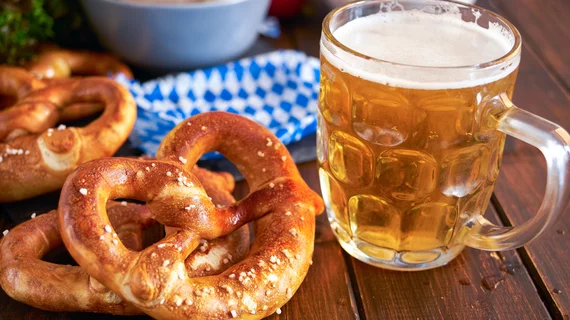Running a CT scanner at Munich’s Oktoberfest: What providers learned
Medical providers deployed a mobile CT scanner at Oktoberfest in Munich, Germany, last year, recently sharing their findings in a research letter published in the New England Journal of Medicine [1].
The publication coincides with this year’s festival, which kicked off Sept. 16, typically attracting 390,000 visitors per day and representing the world’s largest annual fair. Medical experts brought the machine to Munich in the hopes of cutting down on unnecessary emergency transport referrals for mild traumatic brain injury.
All told, 205 patients with presumed or observed TBI underwent 317 scans. Following imaging, 17 patients were referred to a hospital due to the CT results. Another 14 were sent for treatment for other non-trauma-related issues, such as “insufficient sobering up” or persistently poor Glasgow Coma Scale scores.
“The mobile CT scanner ... ruled out serious injury in a considerable proportion of cases [and] might have reduced the necessity of transportation to the hospital and admission for persons with mild traumatic brain injury,” Wilhelm Flatz, MD, with the Ludwig Maximilian University Hospital in Munich, and co-authors concluded, adding that the intervention also “relieved some of the burden on EMS services and hospitals during this unique large-scale event.”
Medical experts made the mobile scanner available from 6 p.m. to 2 a.m. on weekdays and noon to 2 a.m. on Friday through Sunday. Paramedics and EM physicians also utilized an algorithm on-site to guide referrals for persons with mild TBI.
Of those imaged, 191 exams were of the cranium, 67 the midface, and 59 related to the cervical spine. Intracranial bleeding surfaced across 11 patients, 23 had midface fractures and none sustained cervical spine injuries. Patients had an average Glasgow Coma Scale score of 14.
From 2015 to 2019, EMS providers transported about 69.1 patients per day to local hospitals for surgically treated injuries. After implementing the CT practice change, this number dropped to 62 per day in 2022. Flatz et al. also reported fewer mean daily regional trauma-surgical admissions in 2022 for both weekdays and high-attendance weekends.
“In contrast, there was little difference between the mean number of hospital admissions in the combined 16 days before and after Oktoberfest and the periods when the festival was ongoing during 2015 through 2019 and 2022,” the authors reported.

